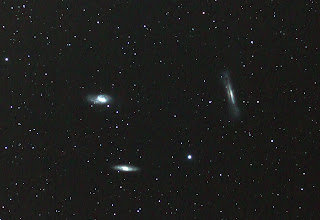After the stacking, I ran my usual initial data stretch and while the extended object detail was great, the background is a complete mess. Looks like a 4 yr old took a red, green, and blue crayon and layed them on their sides and filled in the background with it in swiping motions. I've never seen this issue in my OSC or Mono CCD astrocams. For grins, I also tried repeating the pre-processing using Deep Sky Stacker. EXACT same output. To diagnose a bit further, I repeated the process in DSS and Nebulosity but subtracting each of the calibration file types one by one. The problem doesn't seem to exist in the Darks, Flats, Bias. It's in the light frames. There is color noise/gradient apparent per each unstacked Light frame, but not consistent with the pattern apparent in the stacked exposures. None of the calibration files even reduce the effect in any way, shape, or form. The individual subs are increadibly noisey, as I had anticipated with an uncooled DSLR. But I had also assumed proper calibration and a large stack of quality light frames would have taken care of the problem. The extended objects and stars seem very smooth, but the background is horrific. I'm attaching a crop of the stacked result with a data stretch to help emphasize the effect I'm seeing. (When you expand the image, there are a few dark streaks, and I am aware that this is oversubtraction from darks not being perfectly matched. That part I know how to fix. The rest of the background effect is with no other post processing except a stretch to show it more predominantly.)
Following up on this issue, here's a crop of the stacked results from using only the latter half of the darks, flats, bias, lights, and a stretch only.
Here's a shot of just the latter half of the light frames stacked with no other calibration files added. Interestingly enough, the background issue is gone. Back to analysis on the calibration files I suppose. Must have been way off on the temp matching. More to follow.








No comments:
Post a Comment